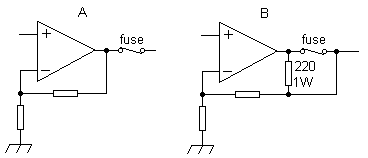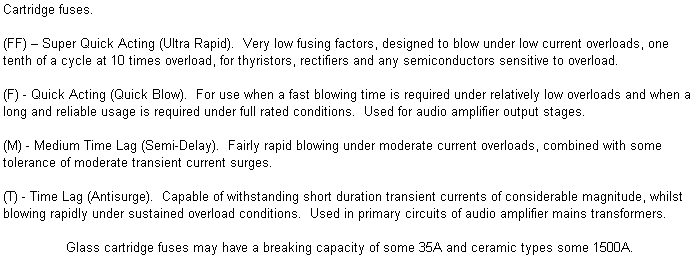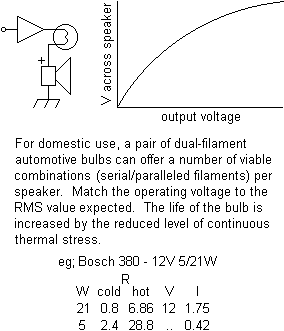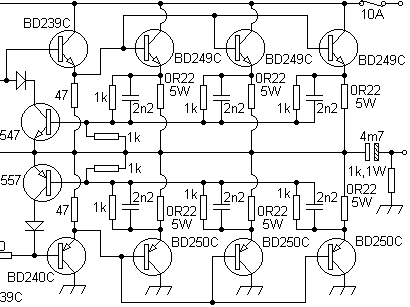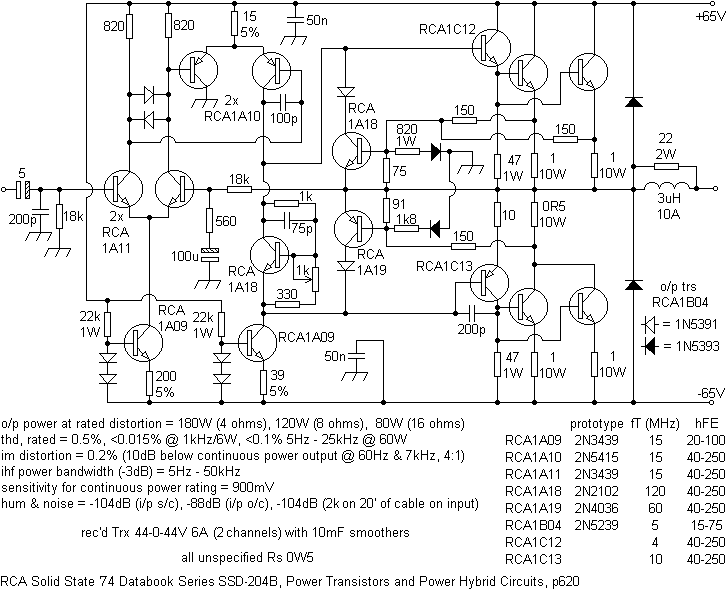Not only is the drive current-limited, but the output, and other areas, are clamped with diodes offering protection from misuse or overloads, eg; two (or more!) amplifier outputs being tied together via sloppy speaker wiring, or reactive speaker loads, which normally spell instant death for most designs. For belt and braces clamp input transistor bases to ground (2 x 2V7 zeners in series, each reversed with respect to each other, 2k2 resistor in series with input capacitor). Mount RCA1A18 on heat-sink and small caps as close as possible to their respective transistors. The 22k, 1W Rs feeding the RCA1A09s can be 11k, ½W, taken to ground, rather than the + rail. A runner, built to last. Nice one, RCA. The 200W version is very similar with an added driver and output pair, appearing in a variety of forms such as the much later FM Acoustic FM800A (40W designs from same databook).
Stripping out the protection (see below), some might say, gives better performance. But others might argue that by the application of a little effort, at the design stage, avoidance of a later major effort can be achieved, given the components that are now vulnerable.

Current-limiting the output can give rise to distortion in the form of clipping when wanted transients trigger the protection. This can be overcome by including capacitors to damp and thus delay the onset of limiting operation, even by a small margin as in the FM800A. Often the voltages at which these will trip will be assymetrical, in another design +4V8 and -6V9, for example. This should be noted, lest reasonable limits be exceeded.
Some may disagree, but the author found a good working example of rugged, well-protected design in the RSD 800b one of which drove four 18" scoops for more than fifteen years without complaint, apart from other incinerated / dropped speakers that the optimistic hoped would work. There is no doubt that the RSD's ability to run 'all day, every day' into any load, at any level, with any user and for so long without ever blowing a fuse, was largely due to the protection employed and the available airflow over it's components, though now appearing dated. Indestructibility is a very desirable feature. The author considers the transient damping employed in the current-limiting to be noteworthy.
Paralleled arrays of output devices spread the thermal load inherent in the output stage. Differences in current gain between output devices can become important, a higher gain device passing more current than a lower gain type and consequently getting hotter. Emitter resistors lift the base voltage as more current is passed, thus helping to limit this effect.
Although adequate performance was given by the Quad 303, Cambridge P-Series and the near theoretically perfect Crown DC300, new speaker designs offered more in terms of low-impedance. The use of very lively speaker loads, such as Quad ESLs and the notorious Linn Isobariks, could present problems where previously there were none, especially if used with 'low-loss' speaker cables.
To cope with adverse loads some designs, like the very hefty Technics SE-9600, had switched feedback giving selectable output impedance (0.08, 0.8, 2.7 and 8 ohms) which reduced the damping factor proportionately. This was apart from three-way thyristor crowbar protection in the power supply and short-circuit, DC and over-temperature circuits for the power amps. Inverse polarity protection diodes, clamping the output to the supply rails, will help with back EMF from the load, a personally-held major contributory cause of output stage failures. Diodes used to clamp supply rails to ground, or outputs to supply rails, should be rated at four times the supply voltage and double the current required to blow relevant fuses. Most Darlington transistors, as with most FETs, include an integral diode.
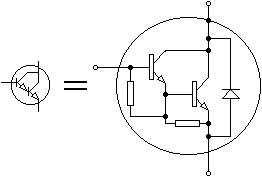
Three different approaches using identical output transistors are shown below, two being built with output stages intended to be capable of dissipating all of the energy from the power supply.
Stan Curtis' ETI System A (1981) used collector current ratings totalling 90A on each side, the output transistors chosen for their large chip and die mounting area (200W, 90V, 30A, 2MHz). This design dissipates 240W, whilst idling, then some more for a 60W output. Lesser power ratings can be found in amplifiers intended to drive loads of 400W+.
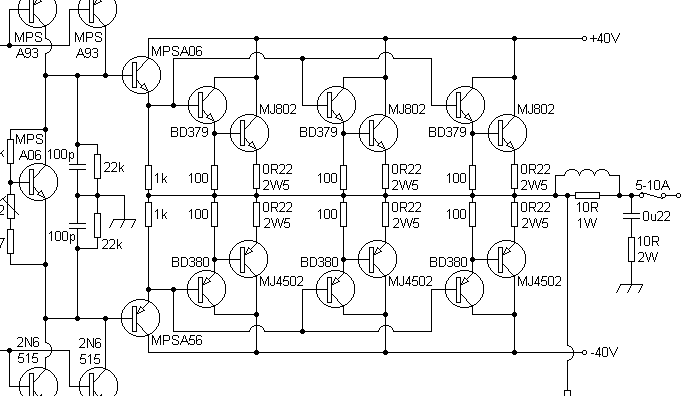
The earlier Lecson AP3 Mk II (1976) mounted the same transistors in series effectively doubling the Vce of the output devices thus increasing the safe operating area (SOA). Capable of delivering 20A to the load, the more conventionally configured BGW 750 could deliver even more. A detailed discussion of a B&O application (Beomaster 4400) can be found here.
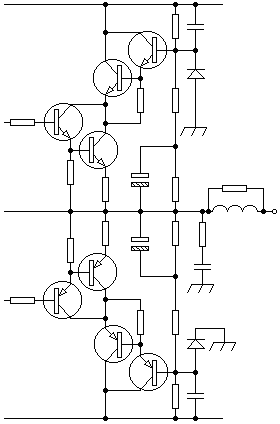
Using the same 'meaty' transistors the Cambridge P60/80 (1975) instead used a FET to reduce the input V in proportion to the output current. This protection only turns on at the equivalent of 50W into a 2 ohm load and when it does it only adds a moderate distortion (0.2% typically) as distinct from clipping.
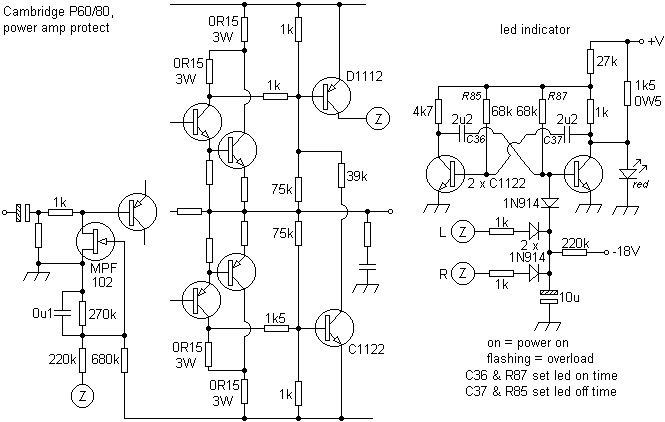
A number of designs have used output current detection to trigger safety circuits (B&O, Mission, etc) and FET input muting has been been used to reduce switch-on transients (B&O, Linsley Hood, etc) and to reduce input levels when high operating temperatures are detected (eg; Technics SE-A7, etc).
Another approach intended to safely handle low-impedance loads together with an alternative output configuration which uses slave transistors to dump current into a low power output stage such as a class A or VFET. Most of the dissipation is in the slave transistors.
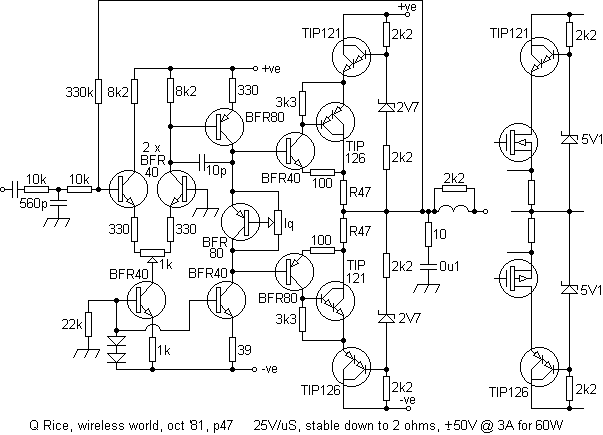
Class G configurations wired additional output pairs in series, each pair fed from it's own (progressively higher voltage) supply. By dividing the 'power bandwidth' between a number of output devices, dissipations were reduced, and smaller (cheaper) output devices with lower ratings could be employed. The 1980 Carver M-400 was a variation of this theme.
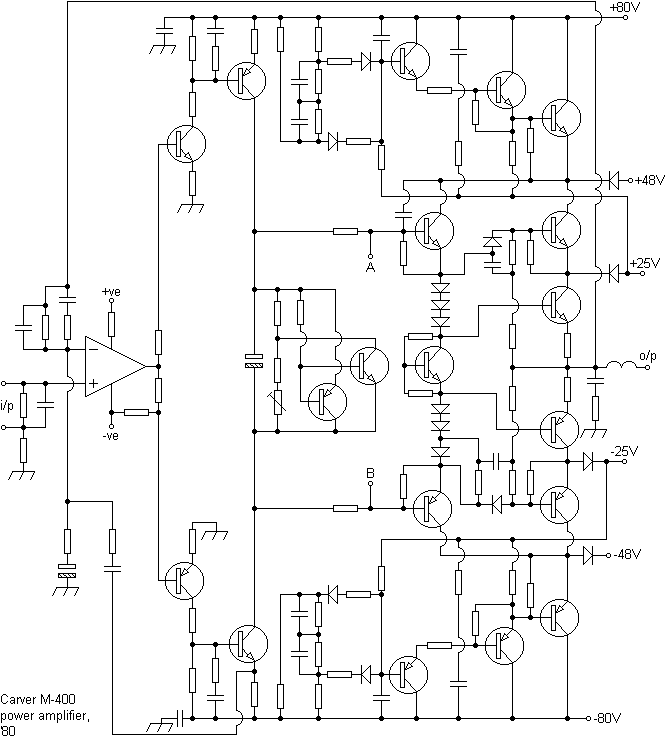
Such output stages could then become quite complex affairs, as can be seen, increasing the component count and thus the possibility of failure. Layouts like this are commonly seen in amplifiers giving outputs of 1kW or more.
The mid-seventies BGW 750A (and the lesser 500D) was, with ten 2N3773 output transistors per channel, intended for rugged professional use and 'built like a tank', as some have put it. No current limiting was included in the output stage this being intended to be capable of dissipating all of the energy from the power supply.
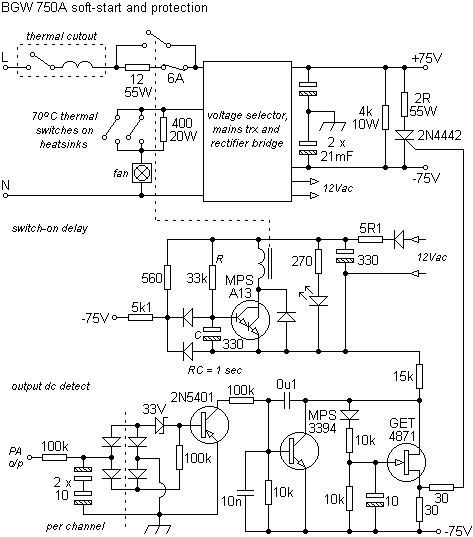
A current cut-out in the mains feed preceded a resistor that was shorted after a one second delay. The cooling fan ran at a slower rate until one of the output stages thermal switches (fitted directly to an output device) came into play then saving motor wear but also indicating inadequate ventilation. The detection of DC on the output lines would fire a thyristor across the supply dissipating the energy away from the speakers, each of which in an array would be protected by it's own fuse.
Class H designs switch in a higher voltage supply to cope with peaks then helping to reduce dissipation. Most use a Darlington series pass power transistor for switching the relevant supply rail to the output devices. Each is triggered by a comparator whose inputs are fed via diodes from the output and a zener reference derived from the supply. In the event of an overvoltage appearing at the output, the comparator then cuts in the higher supply to the relevant supply rail. At the same time, a thermistor can be used to trip the circuit on an over-temperature condition.
Below is the clamp fitted to the output of the 'current-dumping' Quad 405. In the event of an over-voltage, this draws current away from the load, relying on the driver stage's current limiting to save the amplifier (BDY77/2N3773). Left for long under short-circuited conditions, and with fuse protection, Quad 405s simply burn out.
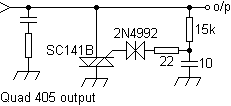
Any arrangement that substantially increases the load on an already overstretched power supply and output stage instead of relieving it cannot be sound. Very definitely, an idea that clearly did not catch on. Ideally, one should isolate or prevent the problem, not exacerbate it.
Using more modern components, a contemporary output array might comprise;

Output pairs can be five times faster with a positive temperature co-efficient and higher voltage ratings. Integral reverse polarity protection diodes can be included, as with some Darlington types. The electrolytics can be high-voltage (250V), high-temperature types intended for switched power supplies.
A number of designs employ exotic and complex protection systems, some more complex than the amplifier itself. Sometimes this is necessary, especially if destructive surges, say through V-FETs without sufficient bias on switch on, are to be avoided. The first Yamaha V-FET power amp design (B-1 series, resembling the once familiar, single-ended, push-pull power stage featuring two pentodes, worth a look simply from an educational point of view) had 39 FETs, 113 transistors, 3 LEDs, 64 diodes and 7 zeners.
Increasing the component count can sometimes be disadvantageous, since obviously, there will be fewer hardware failures and costs will fall if there is less of it, especially if high-voltage supplies (+85V through -200V rails in the B-1, +304V to -12V in the SP-11) are involved. At the same time, any failure in a system which acts upon another, will produce a fault condition which will, in all probability, result in failure of the primary system which is working perfectly. Similarly, if the failure is beyond the owner/user's ability to rectify, finding an engineer locally who is equipped, competent and willing enough to do so promptly is a virtual impossibility. Another example of a (in the author's view overly) complex design, the hybrid Audio Research SP-11 preamp is worth a look, but is not recommended for beginners.
One recalls upsetting a number of 'audiophile' engineers by pointing out that the current from the overload indicator LED in the JLH Hi-Fi News 75W design (BDY56 output Trs) was dumped straight into the base circuit of the Class A driver and a perhaps better approach was to take an overload signal via an opto-isolator paralleled with the current sense resistors for the output current limiters. Apparently, to criticise a Linsley Hood design in some circles is blasphemy. However, this approach has been used to good effect, eg;
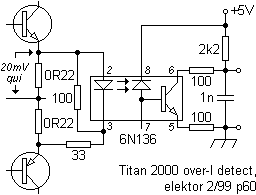
Jose Arjol Acebal's 'professional power amplifier' used comparators to monitor the voltages across the output devices.

The Albarry M408/M1008 (below, courtesy of Trevor Latala) used this technique to limit the input stage, although this might have been seen as academic in the M1008 since the supply voltages were those of the Vce of the output devices with no safety margin. This detracted from a design that otherwise attracted positive comment in sonic terms.
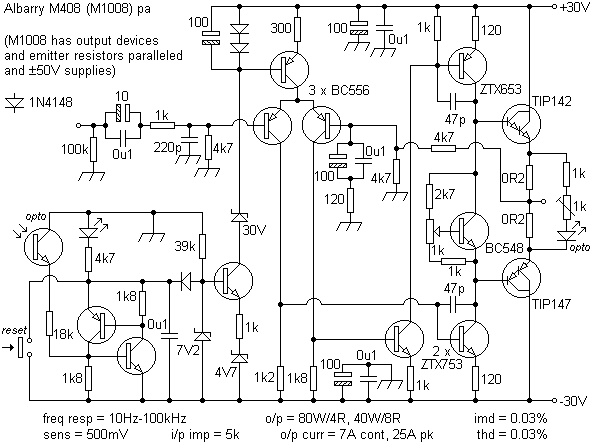
The thyristor action, requiring a manual reset, "prevents the user screwing the nuts off the amplifier", but has proved too sensitive for some users who have either disabled it or employed other protection circuits. The author considers that a marrying of optical techniques with an input limiting technique, as used in an older design, might prove more useful. Some form of interaction with the user and the protection circuitry is considered vital, unless, of course, a 'fire-and-forget' system is designed. Unfortunately, these can be more complex than the amplifier itself. Trevor has suggested that Sanken STD03P/STD03N (160V, 15A, 160W) devices are suitable replacements for the TIP types.
A simple 'add-on' protection circuit is shown below.
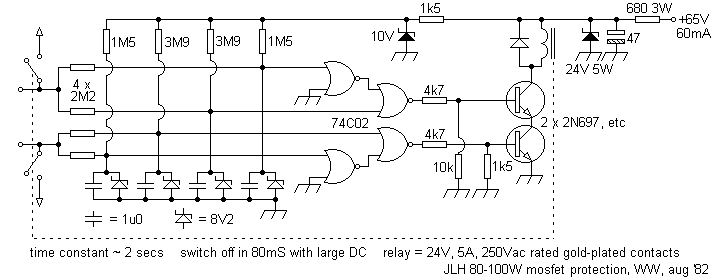
Regulators for power stages are not normally considered and can be more complex than the hardware they protect. The use of an active regulator for power amps can be driven by the low impedance offered. To match this in terms of µF, one would require capacitors of, say, 1F, a less than compact, inexpensive or reliable solution. Smaller main smoothers can then be specified, a good example being the JLH 80W mosfet amplifier. Dissipations can increase bulk and reduce efficiency thus increasing consumption, eg; the SE-9600 mentioned above could use 960W whilst delivering 185W/4R or 110W/8R with both channels. Some systems allow for a fast shutdown negating the need for an output relay. However, problems can occur with spurious triggering caused by LF signals, especially from digital media, notwithstanding the conflicts that can arise from accommodating transients and protection. The time constants involved may then require an empirical evaluation since a theoretical and faster one may disappoint.
False triggering of safety circuits can damage a company's reputation, as B&O found. One quadrophonic remote-controlled tuner amp needed 157 transistors and ICs, 160 diodes, 706 resistors, 413 capacitors, 24 coils and 14 indicators. That's apart from a motor, transformer, switches, fuses... and a fault switch which cut the supply. Unfortunately, for all involved, the triggering circuit was too sensitive. This was followed by a series that shorted their transformer secondaries with a triac, thus, and very effectively, blowing their mains fuses, under fault conditions. Again, sensitivities proved too high and later modifications recommended the triac's removal altogether, thus removing the intended protection (and an excellent method of stressing a perfectly good transformer!). A more modern unit from another supplier employs this technique and uses a 90°C bi-metallic switch fixed to the case/heat-sink to trigger a triac that then shorts the mains transformer's primary. The more 'stylish' or compact a sealed case or enclosure, some are no more than extruded aluminium sections, the less ventilation there is likely to be. Perhaps an intermediate threshold that reduces the amplifier gain, or input, would enable the unit to continue functioning without the risk of 'sudden death'.
The same bi-metallic thermal switches (eg; Microtherm) have been used in amplifiers where they interrupt transformer primaries, a less drastic solution perhaps but still rendering the amplifier, albeit temporarily, inoperative. If these are used, a high-voltage ceramic capacitor fitted across the contacts will reduce arcing and subsequent wear. Lower rated current types, in TO220 cases like those from Airpax, can be fixed to a heat-sink to trigger safety circuits on a power amplifier PCB. Solid-state MOXIE types are even smaller. The thermal hysteresis is much tighter with solid-state types being some 15°C with bi-metal types. In all cases, the use of thermal compound between the sensor's and transformer's or heat-sink's mating surfaces will increase sensitivity and reduce hysteresis, especially if the use of close tolerance types is required. When used a thermal cut-out may be evidence of production shortcuts or constraints to reduce costs and a possible 'quick-fix' solution to resolve fire/thermal damage issues in prototypes. An empirical approach can determine whether a lower operating temperature is worth considering, 90°C being, in the author's view, too hot for an amplifier, given the inevitable thermal resistance between the sensor and the devices being protected. Perhaps a wiser limit to consider is 75°C.
The Technics SE-A7 was a very slim amplifier (just over 2" high) intended to deliver 2 x 60W or 120W in bridge mode. Heat sensors not only monitored the heat-sinks but the main smoothing caps as well. This last was set to trip at 90±5°C.
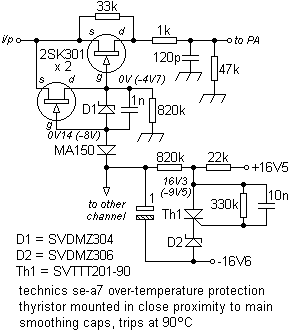
Using FETs, as in the SU-A8 stereo DC control amplifier, this resulted in a -3dB drop in the amplifier output which was thought to be a good idea and was reset by turning the power off and on. However, it was felt that an output should then have been taken to an indicator to show that over-heating had occured, since non-technical owners would then simply, on hearing an apparent drop in volume, turn it up, thus negating the very point of this circuit's inclusion. Perhaps an approach could have been considered to variably reduce the gain of the amplifier in proportion to temperature before limits were exceeded. Apart from a SVITA7317P muting/relay drive IC used to detect power and any output DC, this amplifier used additional circuitry to set both it's transformers secondary voltages (via an additional relay) by detecting the load's impedance, prior to power up (37-0-37Vac for 8~16R and 32-0-32Vac for 4~6R) thus helping to reduce output stage dissipation. Compare to class H operation.

The heat-sinks used, on opposite sides of the unit, resembled the 'heat-pipe' system seen in some Sony amplifiers - a thick bar to which thin fins were crimped, the output devices being fixed to the bar's centre. The left channel's output pair, associated drivers and quiescent current transistor were then mounted away from the main PCB on the other side of the two mains transformers. A connector for one of these circuits was responsible for very annoying spontaneous shutdowns. Whilst the design ethic was appreciated, the author felt that the additional ancillary circuits and particularly the features of the resulting layout that were then used to implement it had possibly impeded the prospect of reliable operation, normally felt to be a solid feature of the Technics brand.
Intended for a 2 x 500W / 1 x 1kW amplifier, the next circuit combined a soft-start, output DC protection and visual indication of condition. An auxillary supply gave ±12V for ancillary circuits and the 15-0-15V AC feed. Combining the amplifier inputs and speaker switching via a single circuit, as with the SE-A7 above, then shuts down both channels when only one malfunctions.

Unfortunately, this short-coming is evident in a number of approaches, take the Kuroda for example.
The Arjol used an output impedance detector but this is reliant on two relay contacts on each output. The imbalance in the protection supply's smoother values, together with the 1k resistor across both rails, increases the rapidity with which the relay shuts off on power down.
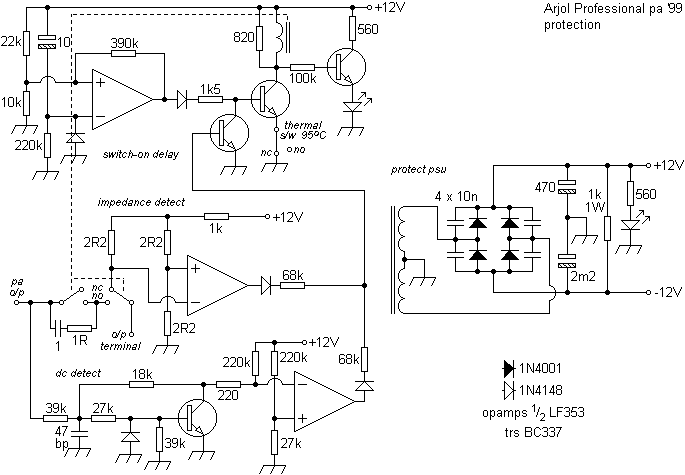
More modern IC design's protection circuits can exhibit unwanted effects. For example, the automotive class H Philips TDA1560Q's output impedance sensor may be activated by spurious impulses arising from speakers as a car door shuts on switch-on, the speaker acting as a microphone. Consequently to overcome this some users can then opt to de-activate the protection networks.
Given the above, perhaps then it should be considered whether a complex arrangement might be too clever and simply 'gets in the way', especially if it has to reset every time the amplifier is switched on, or is reliant on mechanical switch contacts which will invariably deteriorate with time and/or use.
A rule of thumb that emerged gave a safe margin, when using unprotected PAs, if the load (speakers) power handling was in excess of that of the mains consumption of the PA, the load thus being capable of handling safely all available energy from the power supply. Experience suggested that a ratio of 10:1 between the stated or claimed continuous rms power ratings of speaker and amplifier was realistic. Run amplifiers into twice their minimum (or higher) load impedance. This sounds much better, THD and incidence of clipping often being much reduced, and makes the system more resistant to abuse from a casual or abusive user. Damping factors, or the ability of the amplifier to recover from a fast transient, also improve.
The person who can determine a speaker system's impedance by listening to it's performance has yet to be met, experience showing very little subjective or even noticeable difference between 8 or 15 ohm loads. Those who persistently overdrive amplifiers into low-impedance loads are usually blissfully ignorant of the cost of repairs, when required, and will invariably claim burnt-out equipment is inadequate, rather than themselves.
A good source on bipolar power transistor handling and thermal considerations is RCA's Solid State '74 Databook Series SSD-204B, Power Transistors and Power Hybrid Circuits, application notes AN-4124, AN-4612, AN-4783, AN-6163, AN-6215.
The inductor/RC network found on most outputs has a number of functions. The inductance counteracts the capacitance found in some loads, making them appear more resistive to the amplifier and helping to prevent parasitic oscillation. Most speaker leads will have sufficient impedance to counteract this, however, 'low-loss' cables can introduce sufficient capacitance to cause problems. If a highly capacitive load is expected, wire a resistor (at least 1 ohm) in series with it. The transient performance of some designs (square wave ringing) can improve if the inductor is replaced with a non-inductive resistor of, say, 0R22. Simply as an output low-pass filter, the inductance will reduce higher harmonic frequencies.

The RC network to ground loads the output at high frequencies since some amplifier designs can oscillate with no load. This circuit can also help to block RF pick-up by the speaker leads. Oddly, some 'good' manufacturers underate these two components, thus limiting the continuous safe operating high frequency range of their amplifiers by some considerable margin and offering a future cause of potentially harmful oscillation.
Output electrolytic capacitor coupling protects a speaker load in the event of an output device shorting but is now rarely used in hi-fi (though common in low-end commercial audio), but is essential for some class A designs. Whilst an identical type to that used for the smoothers can be used, consideration should be given to impedances presented by this capacitor at both high and low frequencies. Even the better high value electrolytics can become inductive from 10 or 15kHz, sometimes even from 5 kHz. A good HF/RF type (eg; 1 or 2µF polycarbonate / polypropylene) should be paralleled with it to deal with inadequacies at the upper end of the spectrum. A large value electrolytic, say 6m8F, will reduce losses at LF (eg; 1mF @ 20Hz = 8 ohms), surge current ratings set at least twice that expected. A 1k, 1W resistor should tie the output side to ground. Like the smoothers, output caps need ventilation. If desired, AC coupling can be applied to a DC coupled output but the speaker return must then be wired to the -ve rail rather than ground. The voltage rating of the capacitor used should be some 125% of the total supply.
To prevent a speaker being damaged as an output electrolytic charges through the load on switch-on, a simple supply arrangement will bring the supply up slowly allowing the cap to charge at a less precipitous rate. Allow an operating input/output differential of 5-6V. Additional benefits include hum filtering.
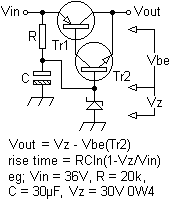
Some situations that call for 'belt-and-braces' will use AC coupling to protect the load from a DC fault arising in the power amplifier, a capacitor being cheaper than a speaker; take 'bullets' or horns in a PA as an example. Protect HF drivers from switch-on transients with a decent high-voltage bi-polar capacitor in series with each; formula = 40,000/fc µF, where fc is the crossover frequency.
Where an output relay is fitted, problems can arise when their contacts tarnish or arc. A thin oxide layer may then block low level signals, which can then be cleared with a burst of power or by actuating the relay by switching the amplifier on and off repeatedly. Ideal contacts are gold (often as an overlay to silver palladium), but these are not often, or economically, available at high current ratings. Other materials can be summarised as follows;
Silver - unsuitable for voltages below 6V because of problems with sulphur.
Silver nickel - same as silver but can sustain higher currents.
Silver cadmium oxide - does not weld easily and is good for mains loads, but not below 12V.
Tungsten - oxidises easily in unfriendly environments but resists arcing and welding. Suitable for heavy loads but not below 24V.
No definitive proof is offered but those systems using soft-starts appear to be prone to fewer failures, perhaps because of the reduced stress on amplifier components on power up, or because the installation is sounder overall demonstrated by consideration having being given to one's inclusion. Where possible, a soft-start can be used as the protection circuit, eg; triggering on DC appearing on the output.
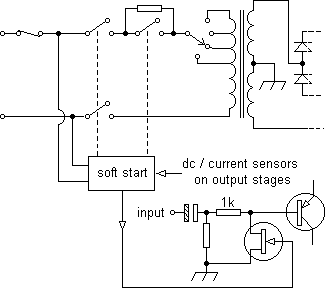
This approach then negates switching the output and a mute output can overlap the switching period. However, for prolonged use, the resistive elements have to be upgraded considerably in terms of wattage in order to cope with the dissipation then experienced. One design seen used an additional relay to discharge the supply electrolytics via substantial resistors.
Class D operation differs considerably, and thus offers altogether contrasting approaches, the speaker being even directly connected to the output devices.
Input protection
Generally speaking, input protection is usually only included in professional equipment or other situations where failure, howsoever caused, is not an option. Since most input damage arises from human failure and inexperience, usually when the power output of an amplifier is plugged directly into the input of another, it is recommended that input protection be included in all designs intended for unknown casual users. PAs, combos, guitar amps, mixers, etc, fall into this category.
Options available include;
A; shows conventional clamping to the supply rails with overcurrent protection given by the resistors. In this case, all overvoltages on either input or output are fed to the power supply which should have a low enough impedance to cope. It should be noted that some opamps will not tolerate input voltage excursions exceeding the supply rails; this approach, then, should be avoided.
B; shows overvoltage protection for a millivoltmeter, the same circuit used to protect another voltmeter with an FSD of 600V.
C; clamping to ground for normally low-level signals, is useful for guitar preamps, often the subjects of abuse/misuse.
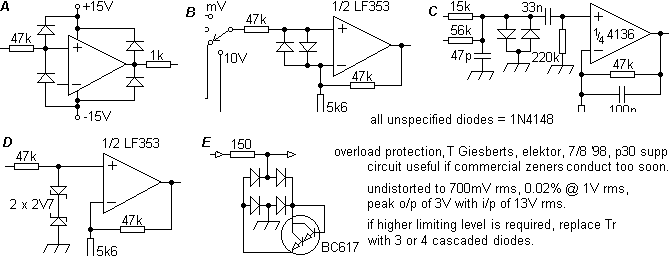
D; 'belt and braces', the input resistor being scaled to suit the application. With a 1k input resistor 400mW diodes will sink 148mA at some 150V, which is more than sufficient. At this level the 1k resistor would have to disspitate some 25W, so a normally chosen small value, say ¼W, will burn out quickly thus 'isolating' the input, a ¼W, 1k resistor's maximum working voltage being nearer 15. An input capacitor will assist dissipation also.
E; an effective alternative approach.
A number of opamps include diode protection across their inputs. Input current must then be restricted (to 25mA or less) to prevent damage.
Clamps can be applied to both non-inverting and inverting inputs of power amplifiers protecting these areas, not only in the event of an input overload, but also if the output is shorted by a failed output device to a supply rail.
Filtering, although despised by some, can prevent damage from DC appearing in the signal chain and afford a reduction in RF harmonics from system by-products or external sources. More effective use is then made of power, especially with equalisation, the PA and speakers not having to cope with inaudible ends of the spectrum, although fast designs like the Stochino can have particularly wide bandwidths, eg;

Distortion |
Power Supplies |
Layouts and Heat-sinking |
Dimensioning a design |
Setting up an audio amplifier
Contact me at paulkemble@hotmail.com
especially if you want additional content to this page
or if you find
any links that don't work. Don't forget
to add the page title or URL. Take care!
Back to index, sound, tips or home.
